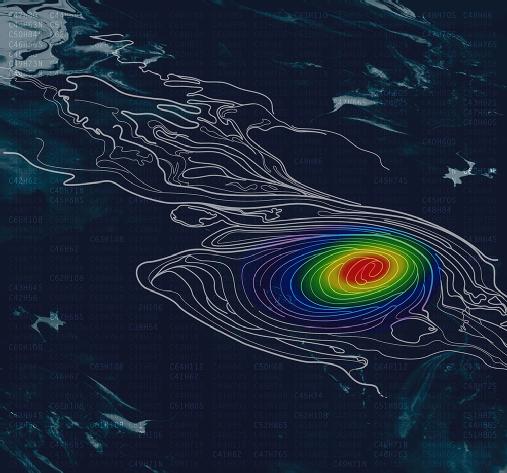Dr. Diana Catalina Palacio Lozano

Dr. Diana Catalina Palacio Lozano |
Senior Research FellowEarly career fellowship 2020 |
| MSc, PhD. Natural Science, Physics |
Contact:
d.palacio-lozano@warwick.ac.uk
Ion Cyclotron Resonance Laboratory
University of Warwick
Coventry
CV4 7AL
Research Summary
My expertise is based in the characterization of the molecular constituents of petroleum-related samples by using ultra high-resolution Fourier transform ion cyclotron (FTICR) mass spectrometry. My expertise also includes the analysis of petroleum-related samples by conventional analytical techniques such as nuclear magnetic resonance and true boiling point curves. In collaboration with industry and academia, vacuum residues and their fractions, waste-water from oil fields and liquid bio-oils have been analysed with petroleomics approaches.
Highlights
Research Image Award for The international Symposium on Energy7
Title: “Petroleomics: Petroleum and its molecular fingerprints

Descripcion: Petroleomics is the characterization of petroleum-related samples using mass spectrometry, typically ultrahigh resolution mass spectrometry. The many thousands of components within these complex mixtures can be assigned molecular formulae and, in doing so, "profiles" or "fingerprints" of samples can be established. The profiles are unique to individual samples and can be used to facilitate useful comparisons, such as crude oils of different origins, outputs from differing refining processes, or petroleum samples exposed to environmental influences, amongst other examples. Thus, ultrahigh resolution mass spectrometry is the state-of the-art for characterization of petroleum-related samples, particularly for the heavier fractions where other analytical techniques may not be viable. One of the methods for representing the data is to create a plot of double bond equivalents (DBE) and carbon number for a single heteroatom class (compound class). The image shows an abstract warping of a DBE plot on to an image of an oil surface. A selection of molecular formulae are superimposed on to the image, reminding the viewer that complex molecular compositions form the basis of all petroleum samples.
Pushing the analytical limits: new insights into complex mixtures using mass spectra segments of constant ultrahigh resolving power
Description: Using a combination of custom-designed experimental and data processing methods, a new strategy has been developed for characterization of the most challenging complex mixtures across different fields. A Fourier transform ion cyclotron resonance mass spectrometer (FT-ICR MS) operating at constant ultrahigh resolution (“OCULAR”) was used to successfully characterize a non-distillable petroleum fraction without the aid of chromatography or dissociation experiments. A resolving power of ∼3 million FWHM was achieved across m/z 260-1505 and a record number of 244,779 elemental compositions were assigned with an RMS error of 0.11 ppm.
Publications
Papers
- Thomas MJ, Jones HE, Palacio Lozano DC, Gavard R, Carney S, Barrow MP. Comprehensive analysis of multiple asphaltene fractions combining statistical analyses and novel visualization tools. Fuel. 2021;291(January):120132.
- Jones HE, Palacio Lozano DC, Huener C, et al. Influence of Biodiesel on Base Oil Oxidation as Measured by FTICR Mass Spectrometry. Energy and Fuels. 2021;35(15):11896-11908.
- Palacio Lozano DCC, Jones HE, Ramirez Reina T, Volpe R, Barrow M. Unlocking the potential of biofuels via reaction pathways in van Krevelen diagrams. Green Chem. 2021. doi:10.1039/d1gc01796a
- Hawkes JA, D’Andrilli J, Agar JN, et al. An international laboratory comparison of dissolved organic matter composition by high resolution mass spectrometry: Are we getting the same answer? Limnol Oceanogr Methods. 2020;18(6):235-258. Co-author.
- Gavard R, Jones HE, Palacio Lozano DC, et al. KairosMS: A New Solution for the Processing of Hyphenated Ultrahigh Resolution Mass Spectrometry Data. Anal Chem. 2020;92(5):3775-3786.
- Ramírez CX, Palacio Lozano DC, Jones HE, Cabanzo Hernández R, Barrow MP, Mejia-Ospino E. The fingerprint of essential bio-oils by Fourier transform ion cyclotron resonance mass spectrometry. Analyst. 2020;145(9):3414-3423.
- Palacio Lozano DC, Ramírez CX, Chaparro Sarmiento AJ, et al. Characterization of bio-crude components derived from pyrolysis of soft wood and its esterified product by ultrahigh resolution mass spectrometry and spectroscopic techniques. Fuel. 2020;259:116085-11094.
- Peru KM, Thomas MJ, Palacio Lozano DC, McMartin DW, Headley J V., Barrow MP. Characterization of oil sands naphthenic acids by negative-ion electrospray ionization mass spectrometry: Influence of acidic versus basic transfer solvent. Chemosphere. 2019;222:1017-1024.
- Gavard R, Palacio Lozano DC, Guzman A, Rossell D, Spencer SEF, Barrow MP. Rhapso: Automatic Stitching of Mass Segments from Fourier Transform Ion Cyclotron Resonance Mass Spectra. Anal Chem. 2019;91(23):15130-15137.
- Palacio Lozano DC, Gavard R, Arenas-Diaz JP, et al. Pushing the analytical limits: new insights into complex mixtures using mass spectra segments of constant ultrahigh resolving power. Chem Sci. 2019;10(29):6966-6978.
- Thomas MJ, Collinge E, Witt M, et al. Petroleomic depth profiling of Staten Island salt marsh soil: 2ω detection FTICR MS offers a new solution for the analysis of environmental contaminants. Sci Total Environ. 2019;662:852-862.
- Ramírez CX, Torres JE, Palacio Lozano DC, et al. Molecular Representation of Petroleum Residues Using Fourier Transform Ion Cyclotron Resonance Mass Spectrometry and Conventional Analysis. Energy & Fuels. 2017;31(12):13353-13363.
- Palacio Lozano DC, Orrego-Ruiz JA, Cabanzo Hernández R, Guerrero JE, Mejía-Ospino E. APPI(+)-FTICR mass spectrometry coupled to partial least squares with genetic algorithm variable selection for prediction of API gravity and CCR of crude oil and vacuum residues. Fuel. 2017;193:39-44.
- Palacio Lozano DC, Orrego-Ruiz JA, Barrow MP, Cabanzo Hernandez R, Mejía-Ospino E. Analysis of the molecular weight distribution of vacuum residues and their molecular distillation fractions by laser desorption ionization mass spectrometry. Fuel. 2016;171:247-252.
- Palacio Lozano DC, Vallderruten JF, Zamora LE, Alcázar GAP, Tabares JA. Effect of Ni on the lattice parameter and the magnetic hyperfine field in (Fe70Al30)100 - xNix alloys. Hyperfine Interact. 2010;195(1):241-247. doi:10.1007/s10751-009-0125-3.
Book Chapter
- Palacio Lozano DC, Chacón-Patiño ML, Gomez-Escudero A, Barrow MP. Chapter 32 | Mass Spectrometry in the Petroleum Industry. In: Totten G, Shah R, Forester D, eds. Fuels and Lubricants Handbook: Technology, Properties, Performance, and Testing, 2nd Edition. West Conshohocken, PA: ASTM International; 2019:1151-1169.
Review paper
- Palacio Lozano DC, Thomas MJ, Jones HE, Barrow MP. Petroleomics: Tools, Challenges, and Developments. Annu Rev Anal Chem. 2020;13:405-430.
